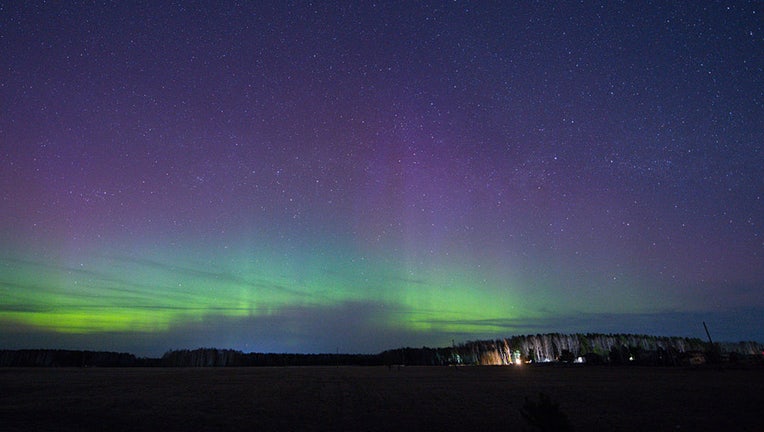Northern lights could be visible again in some US states after weekend solar storms

FILE - A very strong G4-level magnetic storm, caused by a reversal in the magnetic field, led to the appearance of northern lights over the suburbs of the Siberian city of Krasnoyarsk, Russia on April 17, 2025. (Photo by Alexander Manzyuk/Anadolu via
The sun just burped out a coronal mass ejection over the weekend, which means some parts of the U.S. could be seeing northern lights tonight.
Space weather forecasters issued a rare, severe solar storm alert on Sunday, though the worst of any possible disruptions have already passed.
The weekend’s storms may have caused brief disruptions to high-frequency radio, said Erica Grow Cei, a spokesperson with the National Oceanic and Atmospheric Administration.
Which states could see northern lights?
How to see auroras
What you can do:
Northern lights forecasts can be found on NOAA’s Space Weather Prediction Center website or an aurora forecasting app.
Consider aurora-watching in a quiet, dark area away from city lights. Experts recommend skygazing from a local or national park. And check the weather forecast because clouds can cover up the spectacle entirely.
Taking a picture with a smartphone camera may also reveal hints of the aurora that aren’t visible to the naked eye.
What are geomagnetic storms?
The backstory:
The sun’s intense magnetic energy is the source of solar flares and eruptions of plasma known as coronal mass ejections. When directed toward Earth, they can create stunning auroras but also disrupt power and communications.
Galileo was among the first astronomers to turn a telescope skyward and study sunspots, back in the early 1600s. Solar flares and coronal mass ejections tend to occur near sunspots, dark patches as big as Earth that are located near the most intense portions of the sun’s shifting magnetic field.

How to survive a coronal mass ejection
Most of Earth's modern power grids are more than capable of handling a large solar flare or coronal mass ejection but, what if a particularly strong space weather event took place?
Dig deeper:
A solar cycle is a sequence the sun’s magnetic field goes through every 11 years, when the field flips. Geomagnetic storms could become more frequent over the next year as the sun begins to move into the solar maximum phase of its 11-year cycle.
The sun is at the maximum phase of its 11-year activity cycle, making the light displays more common and widespread. Colorful northern lights have decorated night skies in unexpected places and space weather experts say there are more auroras still to come.
Aurora displays, known as the northern and southern lights, are commonly visible near the poles, where charged particles from the sun interact with Earth's atmosphere.
Skygazers are spotting the lights deeper into the United States and Europe because the sun is going through a major facelift.
The sun’s active spurt is expected to last at least through the end of this year, though when solar activity will peak won’t be known until months after the fact, according to NASA and NOAA.
How geomagnetic storms impact the power grid
Northern lights have no impact on human health, but they can potentially cause problems with voltage control, the power grid, low-Earth orbit satellites and high-frequency radio signals, according to FOX Weather.
The Source: Information for this article was taken from the NOAA Space Weather Prediction Center and reporting by The Associated Press and previous reporting by FOX Local. This story was reported from Los Angeles.

